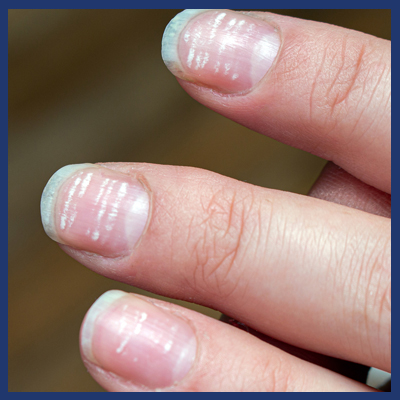

Leukonychia is a condition where white lines or dots appear on your finger or toenails. This is a very common issue and entirely harmless. Many healthy adults have these spots at some point in their lives, so developing them is likely not a sign of a serious medical condition.
For some people, the white spots may appear as tiny dots speckled across the nail. For others, the white spots may be larger and stretch across the entire nail. The spots may affect one nail or several.
The most common cause of leukonychia is injury to the nail bed. These injuries can occur if you pinch or strike your nail or finger. Frequent manicures and pedicures or the use of gel or acrylic nails can also damage nail beds. Several other causes may be responsible for the unusual spots on the nails.
White spots or dots on your nails are common. Several issues can cause them. Possible causes include:
An allergy to a nail polish, gloss, hardener, or nail polish remover may cause white spots on your nails. The use of acrylic or gel nails can also badly damage your nails and may cause these white spots.
A common nail fungus called white superficial onychomycosis can appear on the toenails. The first sign of the infection may be a few small white dots on the nails.
The infection can grow and spread to the nail bed. Toenails may appear flaky and then become thick and brittle.
An injury at the base of your fingernail can cause white spots or dots on your nail as it grows. However, because of the time it takes for your fingernails to grow, you may not recall the injury. Some injuries won’t show up for four weeks or more.
Common sources of injuries to nails include:
Frequent manicures may also cause damage that results in these white spots on your nails. Pressure applied by the manicurist may damage the nail beds.
You may notice white or dots along your nails if you are deficient in certain minerals or vitamins. The deficiencies most commonly linked to this issue are zinc deficiency and calcium deficiency.
Less common causes for white spots on nails include:
While these causes are possible, they are very rare. Your doctor will likely explore a host of other conditions if you have persistent white spots on your nails before considering these more serious issues.
White spots can appear in a variety of ways. They may look like:
The cause for the white spots on your nail may dictate how the spots appear. A nail injury may cause a large white dot in the middle of the nail. An allergic reaction may cause several dots all over the nail. The appearance of the white dots or lines may be different on each nail.
ALUMINA – Panaritium with brittle nails, lancinating pains and tendency to ulceration of finger tips; gnawing beneath the fingernails with crawling along the arm as far as the clavicle; nails brittle or thick, spots on nails. Ingrowing toe nails, white spots on nails.
ANTHRACINUM -Violent burning pain in panaritium; absorption of pus into the blood-gangrenous destruction.
ANTIMONIUM CRUDUM– Deficient growth of nails, split nails, growing cracked.
APIS MELLIFICA– Burning, stinging, throbbing panaritium, very sensitive to touch; the fingers swell rapidly with tense glossy red surface extending to the arm.
ARNICA MONTANA -Ulceration around root of nails, with painful soreness of the end of the fingers.
BERBERIS VULGARIS -Pain under finger nails with coldness of feet, extending up to the ankles and swelling of some of the finger joints.
BUFO RANA -Bluish black swelling around nails, followed by suppuration; pains run in streaks up the arm to axilla.
DIOSCOREA VILLOSA -Nails brittle, deposition to felons; frequent sharp pains in bones of fingers, one finger at a time.
FLURORICUM ACIDUM -Panaritium, onychia with ulceration, sharp, sticking pain at root of right thumb nail. Nails grow more rapidly, crumpled or longitudinal ridges in them; soreness between toes. ingrowing toe nails.
GRAPHITES -Ingrowing toe nail; sides and roots of the finger and toe nails become sore, ulcerate and smell, violently burning and throbbing. Hypertrophy of nails.